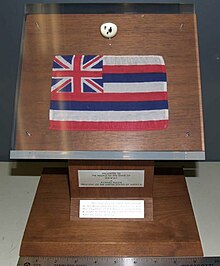Hawaii lunar sample displays

The Hawaii lunar sample displays are two commemorative plaques consisting of small fragments of Moon specimen brought back with the Apollo 11 and Apollo 17 lunar missions and given in the 1970s to the people of the state of Hawaii by United States President Richard Nixon as goodwill gifts.
Description
[edit]Apollo 11
[edit]
At the request of Nixon, NASA had about 250 presentation plaques made following Apollo 11 in 1969. Each included about four rice-sized particles of Moon dust from the mission totaling about 50 mg.[1][2] The Apollo 11 lunar sample display has an acrylic plastic button containing the Moon dust mounted with the recipient's country or state flag that had been to the Moon and back. All 135 countries received the display, as did the 50 states of the United States and the U.S. provinces and the United Nations.[1]
The plaques were given as gifts by Nixon in 1970.[1]
Apollo 17
[edit]
The sample Moon rock collected during the Apollo 17 mission was later named lunar basalt 70017, and dubbed the Goodwill rock.[3] Pieces of the rock weighing about 1.14 grams[2] were placed inside a piece of acrylic lucite, and mounted along with a flag from the country that had flown on Apollo 17 it would be distributed to.[3]
In 1973 Nixon had the plaques sent to 135 countries, and to the United States with its territories, as a goodwill gesture.[3]
History
[edit]Joseph Gutheinz, a former NASA employee and self-appointed private investigator of the Apollo lunar sample displays, reported in 2009 that he did know where Hawaii's Apollo 11 or Apollo 17 "goodwill Moon rocks" plaque displays were.[4] The displays had been stored in a locked cabinet in the governor's office and were located during an inventory in 2010, according to a spokesperson for the governor.[5] The governor's office records showed they had secured both displays, but their exact location was unclear. A senior adviser for the governor's office said they knew all along they were there someplace. The displays were not on exhibit as of 2010.[5][6]
See also
[edit]References
[edit]- ^ a b c Pearlman, Robert. "Where today are the Apollo 11 goodwill lunar sample displays?". CollectSPACE. Archived from the original on November 8, 2020. Retrieved November 2, 2012.
- ^ a b "Tales of lunar rocks through the years". The San Diego Union-Tribune. Associated Press. 2012-05-23. Archived from the original on 2023-02-06. Retrieved 2023-02-06.
- ^ a b c Pearlman, Robert. "Where today are the Apollo 17 goodwill lunar sample displays". CollectSPACE. Archived from the original on 2012-10-15. Retrieved 2023-02-06.
- ^ Hoover, Will (October 23, 2009). "Hawaii's moon rocks go missing". Honolulu Advertiser. Retrieved November 6, 2012.
- ^ a b "Hawaii's missing moon rocks found". The Seattle Times. Associated Press. January 11, 2010. Archived from the original on February 2, 2013. Retrieved November 6, 2012.
- ^ Hoover, Will (January 11, 2010). "Missing moon rocks turn up". Honolulu Advertiser. Retrieved November 6, 2012.
Further reading
[edit]- Kloc, Joe (February 19, 2012). The Case of the Missing Moon Rocks. The Atavist/Amazon Digital Services, Inc. p. 47. ASIN B007BGZNZ8.

